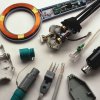Malaysia faces fierce competition from other nations in developing the medical devices sector.
Countries such as Singapore, Turkey, Thailand and India, have an advantage in this area due to their strong research and development (R&D) focus.
Malaysia presented some potential "game-changing" medical care products at the just concluded Medica show of Dusseldorf, the world's largest event for medical care products and technology.
But the country needs to work hard and fast to meet challenges posed by the competitors who are aggressively vying for a slice of the medical care products pie.
Most innovations in the medical and healthcare sector are increasingly electrical and electronics driven.
Malaysian manufacturers of such products should as such tap the country's well developed electrical and electronics industry.
This point was also driven home by S Choudhury, chief executive officer of Penang-based Vigilenz Medical Devices Sdn Bhd, a leading supplier of disinfectants and liquids for hand hygiene.
He told Bernama at the Medica show that in taping into the sector, Malaysia can help find technological solutions for upgrading medical devices and products.
"The resulting cooperation can generate a lot of synergy between innovators of the medical care devices and the electrical and electronics industry," he said.
He also predicted strong demand for prophylactic products against so-called hospital acquired infections (HAI) which pose a potential threat to human health.
"We need innovative products to combat the HAI problem and I believe Malaysia's electronic and electrical industry can come up with solutions," Choudhury said.
According to the Malaysia External Trade Development Corporation (Matrade) , and other sources, Malaysia's exports of healthcare products in 2012 was around RM13.97 billion.
The figure, is however, small in global comparison. A large part of the exports comprise surgical and examination gloves which strictly speaking, are not medical devices but only part of the paraphernalia employed in hospitals and laboratories.
Malaysia's potential in respect of the production of medical devices has still to be fully realised.
Malaysia manufactures an impressive range of medical and healthcare devices that include dental and ophthalmic instruments and appliances, medical instruments, apparatus and appliances as well as heart pacemakers.
Other products include orthopedic or fracture appliances, oxygen therapy artificial respiration and therapeutic respiration apparatus and ophthalmic lenses.
The United States is Malaysia's largest market for the medical devices, followed by Japan, Germany, Singapore and United Kingdom.
The domination of the market by Singapore, Turkey and India among others was evident at the Medica show where they set up national pavilions manned by media-savvy scientists, R&D experts and other specialists.
Singapore touted itself as Asia's leading biomedical sciences cluster that offered the best intellectual property protection in Asia.
It produces 10 % of the world's contact lenses, 40% of the mass spectrometry instruments, and more than 70 per cent of micro arrays and thermal cyclers.
These, in value terms, amounted to 2.8 billion Euros for the global market in 2012.
Meanwhile, Turkey is making an impact in the global healthcare market as Coskun Kirlioglu, the deputy secretary-general of the Istanbul Mineral and Metals' Exporters Association (IMMEA) said.
The IMMEA is an apex organisation of Turkey's industry associations, including medical devices and the like.
"Our medical devices industry has been growing each year. Ankara is Turkey's hub for the medical devices industry and small and medium-sized companies form its backbone.
"Our exports of purely medical devices are projected to touch US$700 million in 2013 after reaching US$650 million last year. We see strong demand for Turkish products in Europe and North America," Kirlioglu said.
Clearly, Malaysia needs to review its performance through greater innovation and cooperation with other related sectors of the medical devices industry, to cash in on the global potential.
source:MJNnews
Boost for Malaysian medical devices sector, urged

